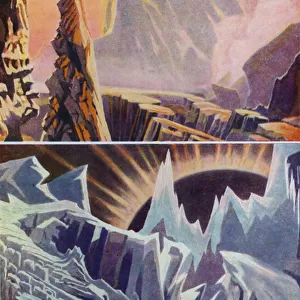Home > Science > Scientists
Solar prominences, 20th Century image
![]()

Wall Art and Photo Gifts from Science Photo Library
Solar prominences, 20th Century image
Prominences were observed in the 19th century during solar eclipses, This one was photographed in the early 20th century during a total solar eclipse in 1909. A prominence is a large, bright feature extending outward from the Suns surface, often in a loop shape. Prominences are anchored to the Suns surface in the photosphere, and extend outwards into the Suns corona. While the corona consists of extremely hot ionized gases, known as plasma, which do not emit much visible light, prominences contain much cooler plasma, similar in composition to that of the chromosphere. A prominence forms over timescales of about a day, and stable prominences may persist in the corona for several months. Some prominences break apart and give rise to coronal mass ejections. Scientists are currently researching how and why prominences are formed
Science Photo Library features Science and Medical images including photos and illustrations
Media ID 6355839
© Detlev van Ravenswaay
1900s 1909 Astrophysical Astrophysics Corona Coronal Eclipse Feature Features Flare Flares Moon Prominences Solar Eclipse Solar Prominence Solar System Star Surface Total Eclipse
EDITORS COMMENTS
This print captures a mesmerizing sight from the early 20th century - solar prominences during a total solar eclipse in 1909. These remarkable features were first observed in the 19th century, exclusively during solar eclipses. Anchored to the Sun's surface, these large and bright loops extend outward into the corona, contrasting against the black background of space. While the corona consists of scorching ionized gases that emit little visible light, prominences are composed of cooler plasma similar to that found in the chromosphere. Taking shape over approximately a day, stable prominences can endure for months within the Sun's atmosphere. However, some may break apart and trigger coronal mass ejections. Scientists continue their relentless research into understanding how and why these stunning formations occur. This historical image provides astronomers with valuable insights into our star's behavior and its intricate relationship with its surroundings. Detlev van Ravenswaay skillfully captured this astronomical marvel through his lens, allowing us to appreciate both its beauty and scientific significance. As we gaze upon this print, we are reminded of humanity's ceaseless curiosity about our place in the vastness of space and our ongoing quest to unravel its mysteries.
MADE IN AUSTRALIA
Safe Shipping with 30 Day Money Back Guarantee
FREE PERSONALISATION*
We are proud to offer a range of customisation features including Personalised Captions, Color Filters and Picture Zoom Tools
SECURE PAYMENTS
We happily accept a wide range of payment options so you can pay for the things you need in the way that is most convenient for you
* Options may vary by product and licensing agreement. Zoomed Pictures can be adjusted in the Cart.



